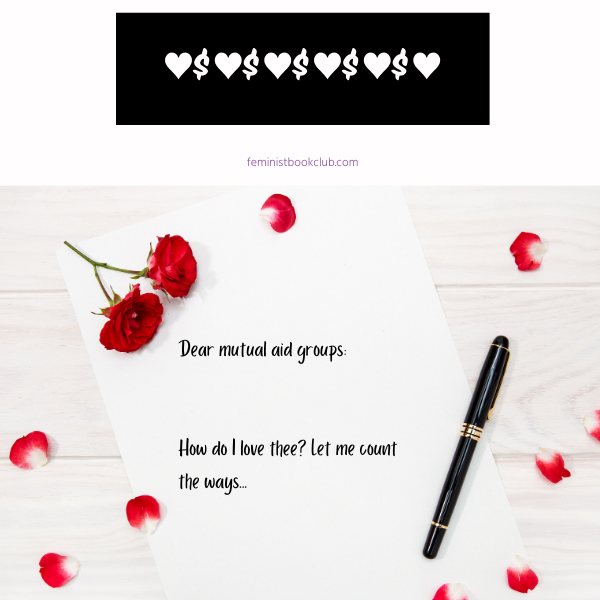I spend an inordinate amount of time every year trying to figure out the most efficient way to stretch my freelance income so as to donate to as many social justice organizations as possible.
Should I send my money to big organizations like Black Lives Matter and Southern Poverty Law Center that are doing work in areas I care about? Or should I focus on the small organizations like Music Beyond Measure and the Masakhane Center that are doing good work closer to home? When I shop from the evil behemoth that is Amazon, should I send my Smile bucks to RAINN… or should I instead support the Helene Johnson and Dorothy West Foundation for Artists in Need? When I subscribe to newsletters like those from Anti-Racism Daily and SURJ (Showing Up for Racial Justice), which share action items and donation recommendations, how do I know which ones to focus on? I mean, I could always send an eensier amount to a larger number of organizations. But then, am I actually helping?
Helloooo Mutual Aid Networks!
In early November, Nicole Cardoza sent out an issue of the Anti-Racism Daily newsletter (have I mentioned that I’m obsessed with Nicole’s Anti-Racism Daily newsletter?) that focused on how we might want to lend our support to mutual aid networks versus larger charitable organizations. I had been seeing more about mutual aid networks across the media in preceding months, but Cardoza’s newsletter really broke down the pros of donating to a mutual aid group in a way that was simple and accessible. It laid out how mutual aid was about communities coming together to tackle root problems they’d been living with, while large charities operated from a framework of deficit, moving resources from “places of abundance to places deemed as needy.”
The problem with this? Smaller communities can often be overlooked, and the smaller social justice organizations that serve them may struggle because of lack of funding.
Cardoza’s newsletter also touches upon the white savior complex that can be inherent in larger organizations, where those in charge may think they know better than those they purport to serve.
Mutual aid networks, meanwhile, empower those most affected by lack, allowing them to tackle head-on the problems they face on a daily basis.
When I Realized There Was a Mutual Aid Network Right in My Backyard
At the time I read this newsletter, I was in the midst of looking for new and creative ways to support social justice organizations. As with so many others, my income had been adversely impacted by the pandemic, but I wanted to continue giving what I could. And I wanted to be smart about it.
After reading more about mutual aid networks, I pored through the state-by-state list on the Mutual Aid Disaster Relief website and went down an internet rabbit hole. Somehow, I landed on Black Lives Matter Paterson, a group that wasn’t even on the initial list, but which was providing essential community support in the town right next door to the one in which I’d grown up.
I began to follow them on Instagram. I watched as they delivered dinner to seniors in town. As they provided free glucose and blood pressure screenings. As they handed out PPE (personal protective equipment). As they trained community members to be “immediate responders,” able to treat bullet and stab wounds.
More recently, they opened a community fridge, where community members can get free food and beverages. Others who have something to spare can drop off refrigerated and freezer items.
Initially, the group was accepting monetary donations through Cashapp. But they recently launched their Patreon, making it easier to set up a recurring donation. And money isn’t the only way to help. I’ve been gathering coats and other winter wear, which they hand out to residents on a regular basis. They also collect food, hygiene products, and toys, all of which they provide to those in the community for free.
I love seeing how they’re giving back directly to their community. How they’re supporting each other. In supporting a group run by a community for that community, I can know that people are getting exactly what they need.
Consider Supporting a Mutual Aid Group Near You
Of course, supporting a mutual aid network doesn’t mean you can’t or shouldn’t also support local nonprofits or larger charities. But opting to add mutual aid to your annual giving can give you the sense that what you give is getting to where and who it’s most needed.
In addition to checking out the list of groups on the Mutual Aid Disaster Relief website, you can scroll through this Google Spreadsheet, which contains information on mutual aid networks, bail funds, organizations, and more.
If you’re actively engaged in social justice work within your community (which I know many of our rock star members are), this Mutual Aid 101: Toolkit from Alexandria Ocasio-Cortez and her team is well worth the read. It contains tips on how to safely build your own mutual aid network while in the midst of a pandemic.
And if you’d like to learn even more about mutual aid, lawyer, writer, and trans activist Dean Spade recently published Mutual Aid: Building Solidarity During This Crisis (and the Next). He also put together a list of five other books that explore how mutual aid projects have been part of other powerful social movements.
I’d love to hear more about the mutual aid networks in your communities. Let me know what’s going on in your neighborhood in the comments below!


